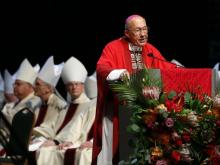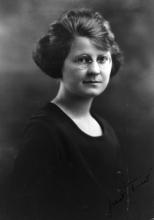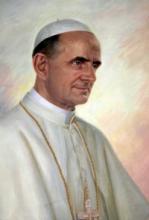beatification

In an apostolic letter read in Latin by Amato and English by Oklahoma City Archbishop Paul S. Coakley, Francis praised Rother as a priest and martyr “who was driven by a deeply rooted faith and a profound union with God, and by the arduous duty to spread the Word of God in missionary lands.”

“It’s hard to really put into words,” said Marita Rother, a nun and younger sister of the priest who was shot to death on July 28, 1981, while serving as a Catholic missionary during Guatemala’s bloody civil war.
“I think the whole thing is beyond what any of us would expect to be happening,” she added.

As he wraps up a Vatican meeting marked by sharp debates over sex and morality, Pope Francis on Oct. 19 will honor one of his most controversial predecessors by beatifying Pope Paul VI, who is most famous for reaffirming the Catholic Church’s ban on artificial contraception.
Beatification puts Paul one step shy of formal sainthood. The move might seem out of step with Francis’ pastoral approach given that Paul’s birth control ruling, in the 1968 encyclical “Humanae Vitae,” set the stage for the culture wars that overtook Catholicism after Paul died in 1978.
A wide swath of Catholics, especially in the U.S. and Europe, were furious over Paul’s decision. They were convinced that the ban would be lifted and that Paul was shutting down the reforms that had begun a few years earlier with momentous changes adopted by the Second Vatican Council.
Many conservatives, on the other hand, hailed “Humanae Vitae” for reasserting traditional doctrine, and the division foreshadowed the deep splits that have played out even in this month’s high-level synod in Rome — a polarization that Francis says he wants to overcome.
Yet Francis is trying to accomplish that goal by focusing not so much on “Humanae Vitae” but on Paul VI’s many other groundbreaking, though often overlooked, contributions:

New Jersey is often dismissed as a cultural wasteland of traffic jams and suburban sprawl, mobster graveyards and lost dreams — source material for native son rockers like Bruce Springsteen and Jon Bon Jovi.
But soon the state may also be known as home of the latest American saint, a Bayonne-born nun who is to be beatified in Newark next month.
The beatification of Sister Miriam Teresa Demjanovich, who died in 1927 at the age of 26, puts her one step away from formal canonization.
If Demjanovich does make the final hurdle, she would become just the second person born in the U.S. ever to be named a saint, and it would give New Jersey something to brag about — albeit humbly, no doubt.

It’s almost a year since Pope Francis was chosen as Benedict XVI’s successor. The Argentinian-born pontiff has quickly achieved global fame for his numerous statements indicating that significant changes may be coming to the Roman Catholic Church.
One possible change emerged last month when London’s Sunday Times reported that Francis wants to make public the Vatican’s archives of Pius XII’s pontificate. Eugenio Pacelli became pope in 1939 and served as pontiff during the period of World War II and the Holocaust until his death in 1958.
According to the British newspaper, Francis wants to release the Pius XII papers for study before determining whether to consider his controversial predecessor for sainthood. Francis has already “fast-tracked” the path to sainthood for John XXIII and John Paul II, but not Pius XII.

VATICAN CITY — Pope Paul VI, who guided the Catholic Church through a tumultuous period of change in the 1960s and 70s, took a crucial first step toward possible sainthood when Pope Benedict XVI last week recognized his predecessor’s “heroic virtues.”
Paul VI is now considered “venerable” in the Catholic Church, and needs the Vatican to recognize a miracle due to his intercession in order to be beatified, or declared “blessed.” A second miracle would then elevate him to sainthood.
Giovanni Battista Montini (1897-1978) was elected to the papacy with the name of Paul VI in 1963. He oversaw the implementation of the modernizing reforms of the Second Vatican Council (1962-1965).